You may not find this terribly rewarding unless you're included here, so this is a good time for casual and random browsers to turn back before they get too caught up in the sweep and majesty of the proceedings and can't let go.
17 May 2018
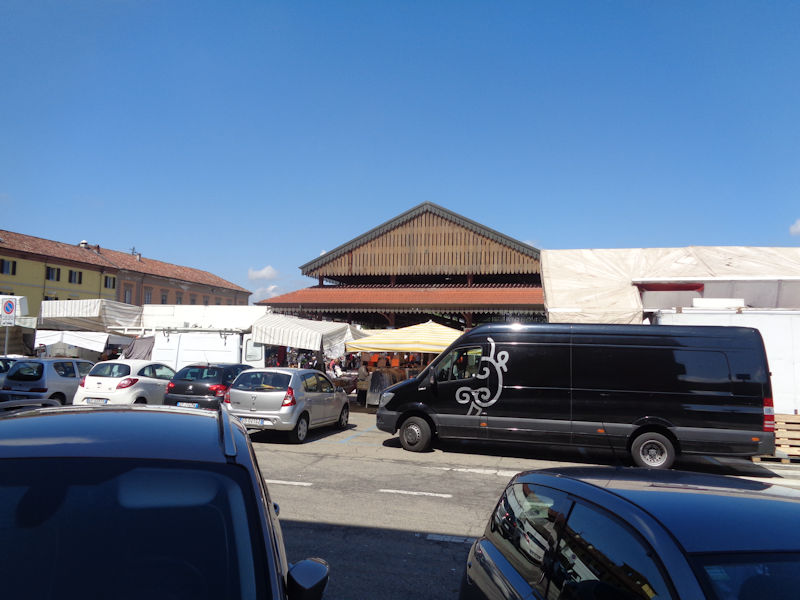
Our first visit to Alba in the province of Cuneo, about 50km southeast of Torino, 17 May 2018. We've come upon a street market and covered market with carpark at the northern end of the centro storico . . .

. . . and chanced upon probably the best parking space in town (note that cute little Volvo; named Sven).
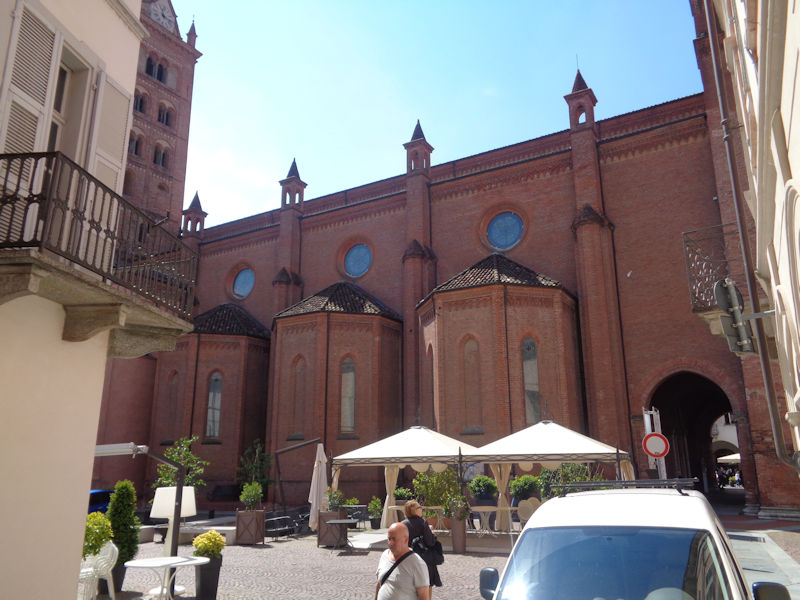
First things first: people like us, who do not arise with the first ray of sunlight on the treetops, when sightseeing in an Italian town, must dash first to the Cathedral before it closes from noon to three.
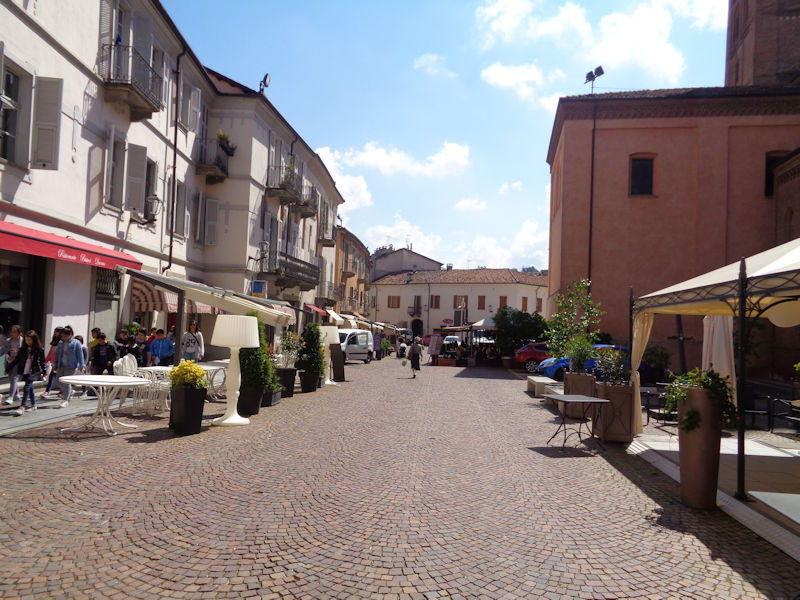
We're rushing past the Piazza Risorgimento along the side of the Duomo out onto . . .
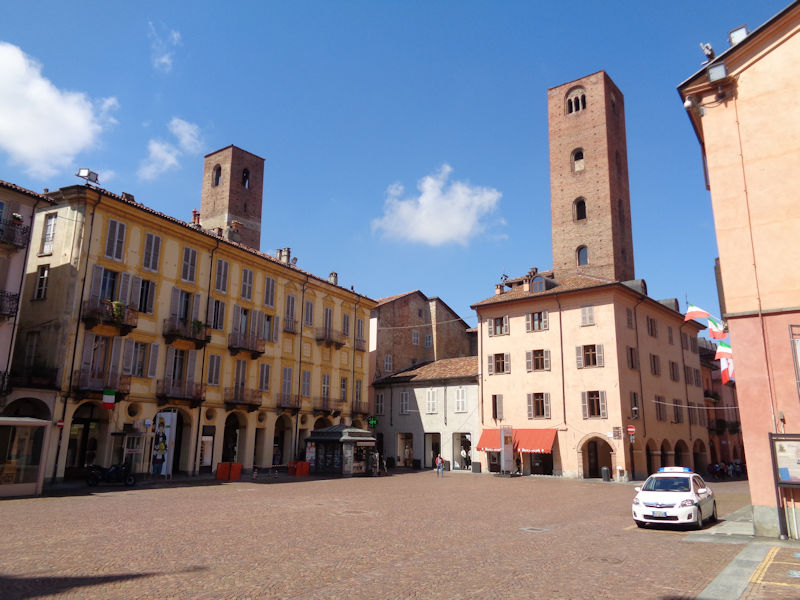
. . . the Piazza Risorgimento, or Piazza Duomo, in front of the Cattedrale di San Lorenzo, or Duomo di Alba. Alba claims to have once been known as 'the city of a hundred towers' (like many northern Italian towns, perhaps), of which only about ten of the 14th and 15th century civic towers and a few more on the churches remain. With the growth of stronger municipal governments in the later Middle Ages, and the decline of family and factional warfare in the city streets, the private towers in most cities were cut shorter or destroyed.
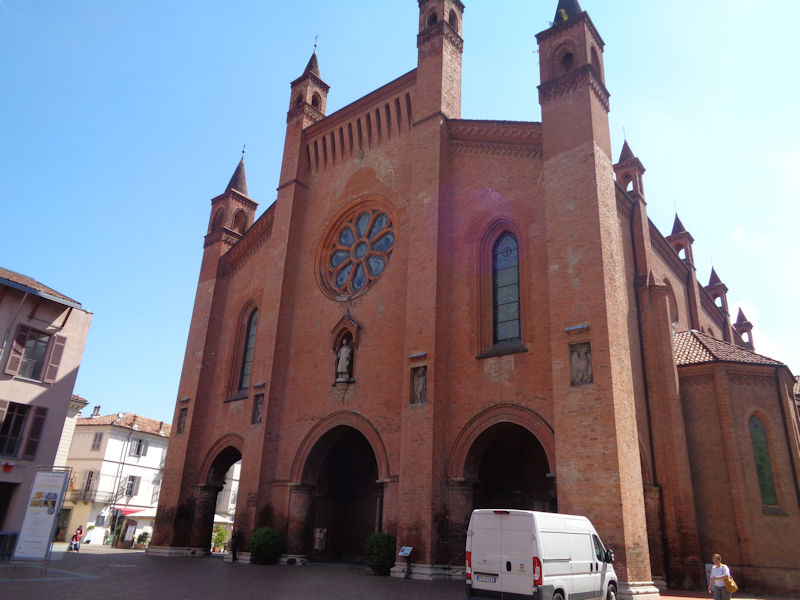
The Cattedrale di San Lorenzo, dedicated to the patron saint of Alba, San Lorenzo or St Lawrence. There was an early Christian church on the site as early as the late 400s, and a Romanesque successor built upon its ruins, before the present buildings were begun in the early 12th century. Renovation to a more Gothic style was carried out in the late 15th century and again in 1652 to repair earthquake damage. The most significant reconstruction, however, was done in the 1870s and was controversial in some respects, and there were additional restorations beginning in 2007.
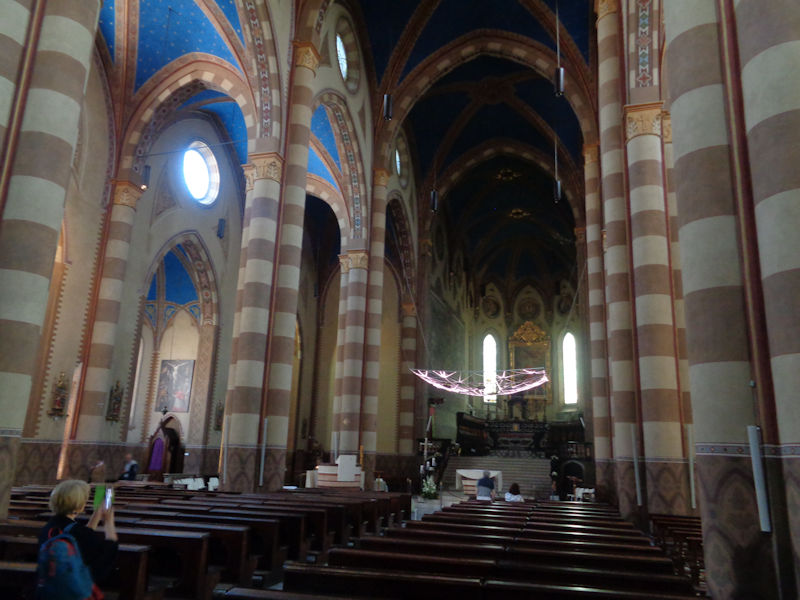
An impressive nave with two side aisles in a Latin Cross configuration.
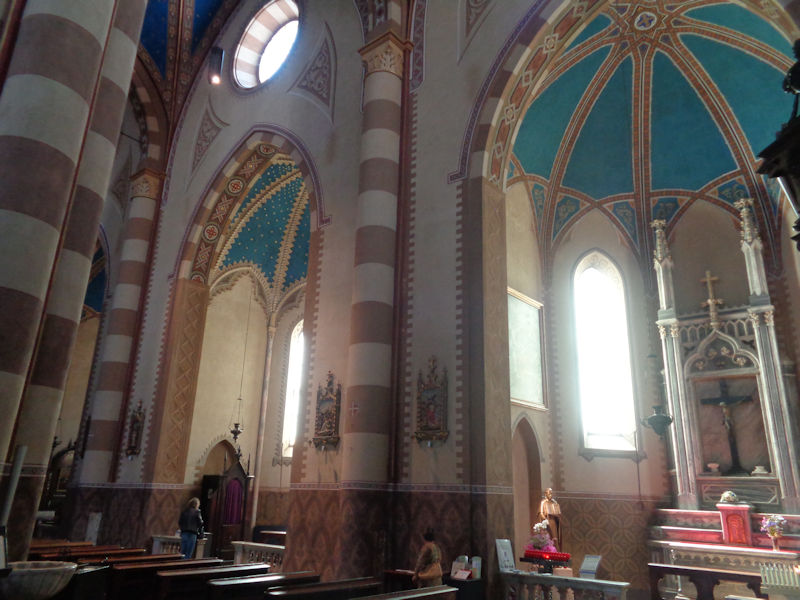
Side chapels along the aisles
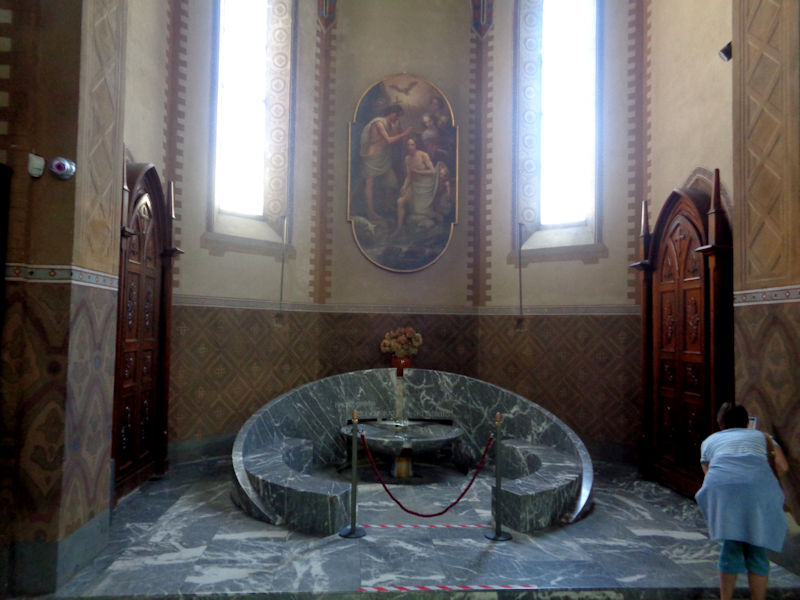
A little touch of fanciful modernism for the baptismal font
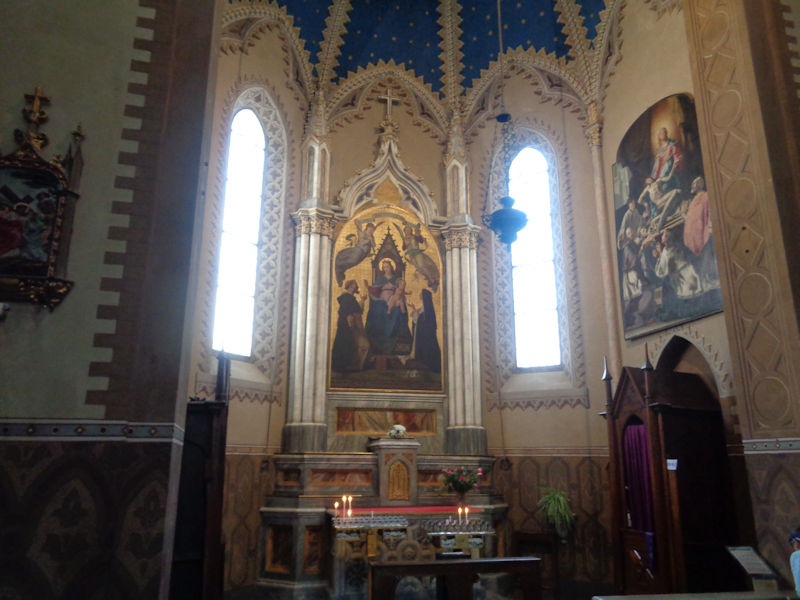
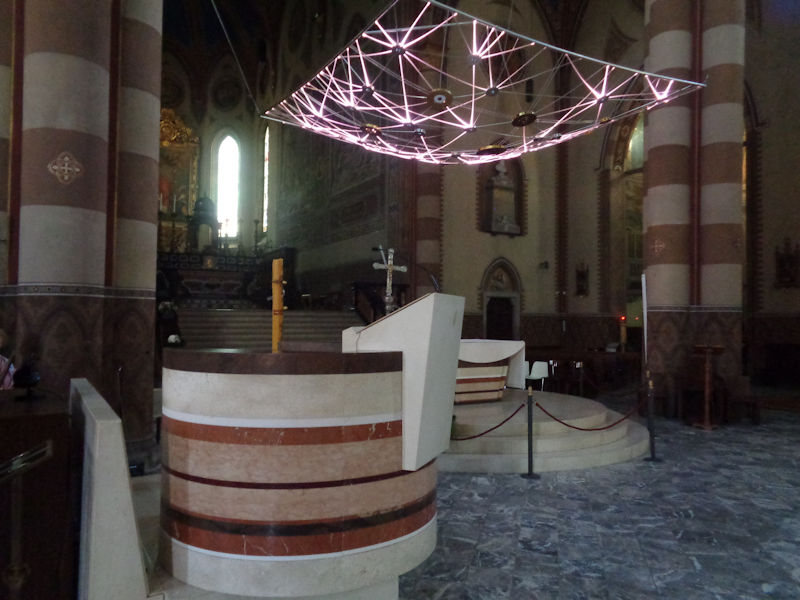
The pulpit and front altar under some kind of canopy of lights
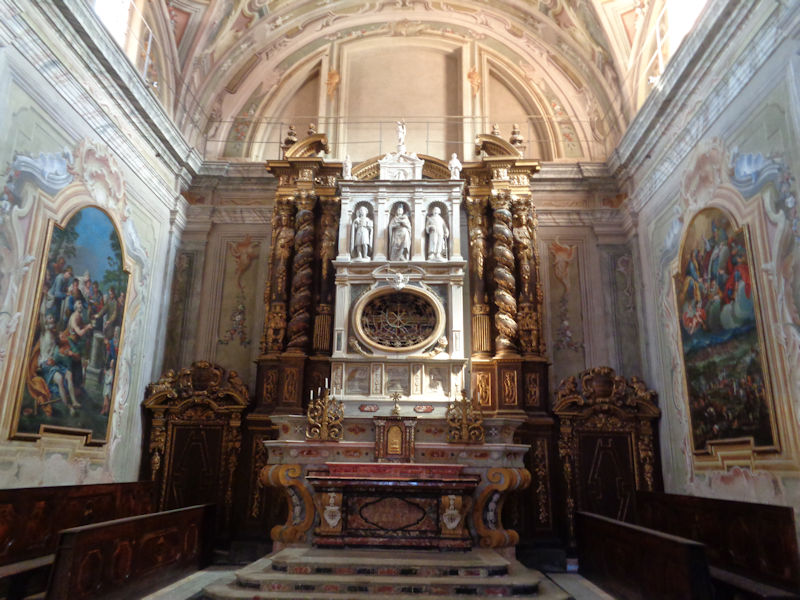
The Chapel of St Theobald, dedicated to the 12th century cobbler's assistant known for his generous gestures towards the poor, including at least one miracle. After his death in 1150, his reputation spread and Alba became a pilgrimage destination, donations from which allowed major improvements to the Duomo.
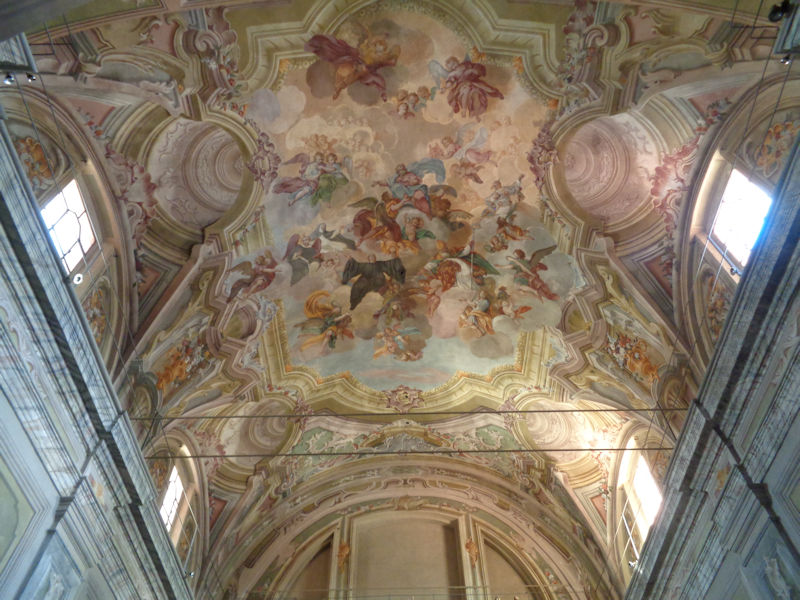
The ceiling of Theobald's chapel
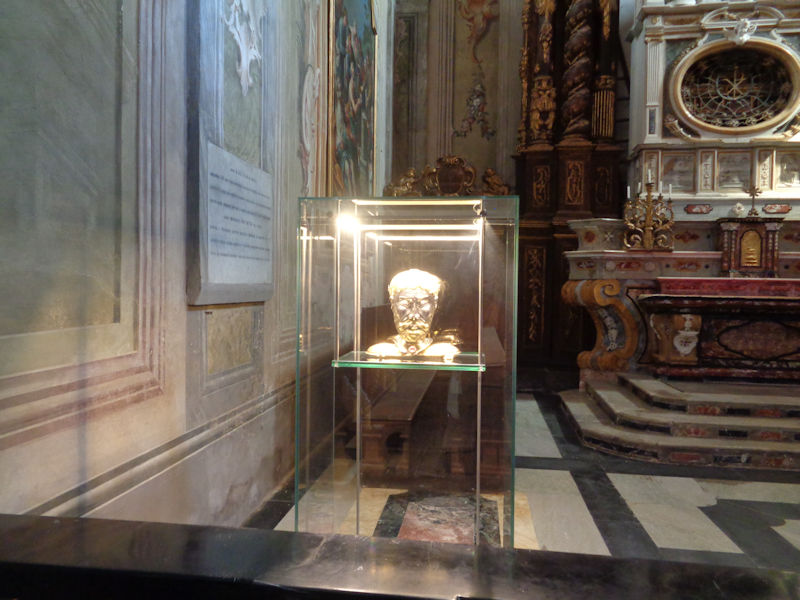
In 1429, Teobaldo's remains were miraculously discovered by the then-Bishop, and now his head's in that chiseled silver reliquary. Celebrations are still held for St Theobald on his saint's day, sponsored by the Shoemaker's Guild.
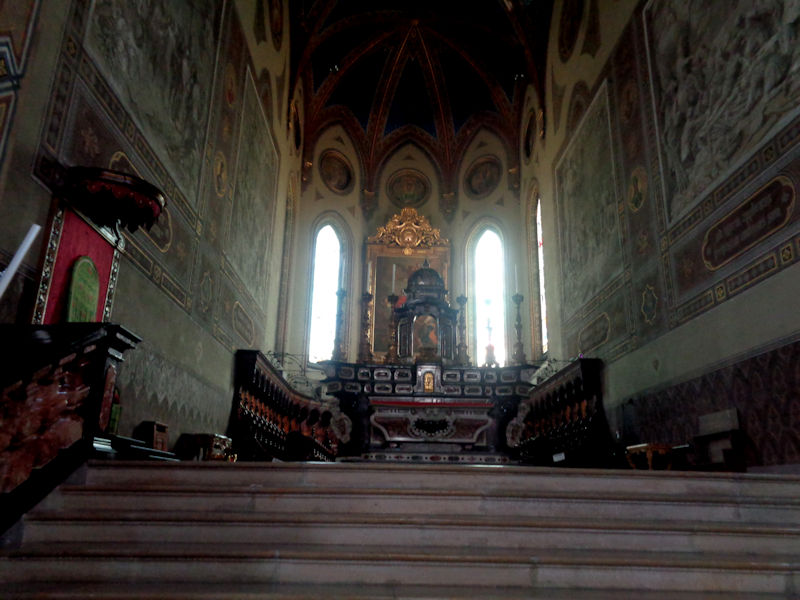
The 35 carved-wood chorus stalls in two semicircles, built in 1512, are famous for their imaginative Renaissance marquetry and diversity of subjects. But we can't see them from here.

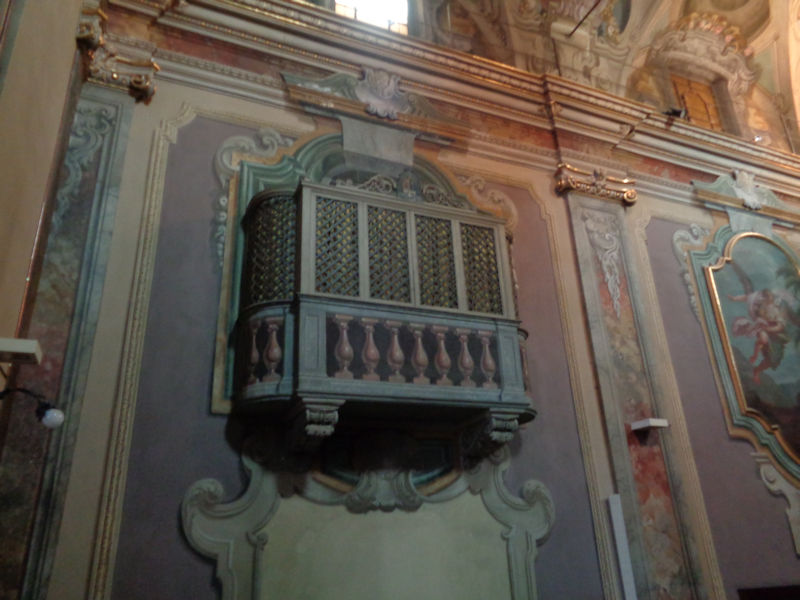
Back home three weeks later, it's too late now to figure out whether that thing, probably a nuns' gallery, is real or trompe-l'oeil.
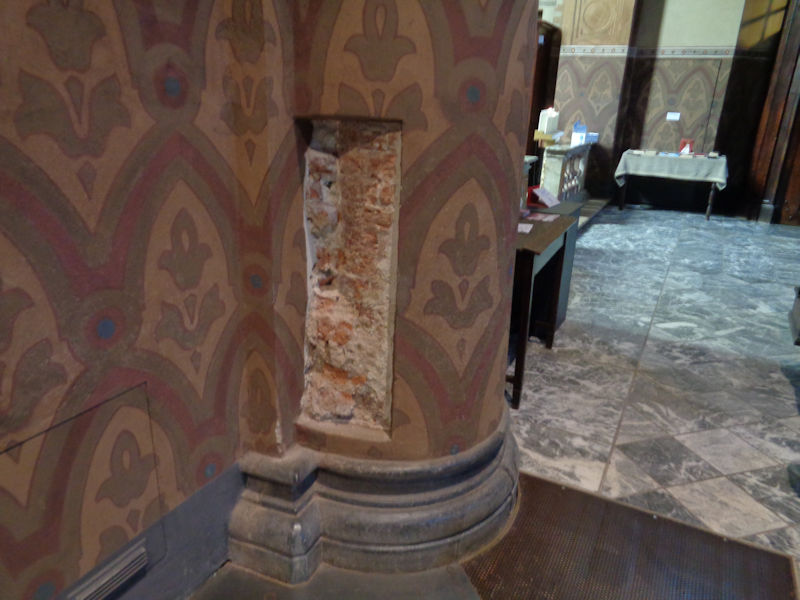
A permanent reminder of the state of the original columns before subsequent renovations
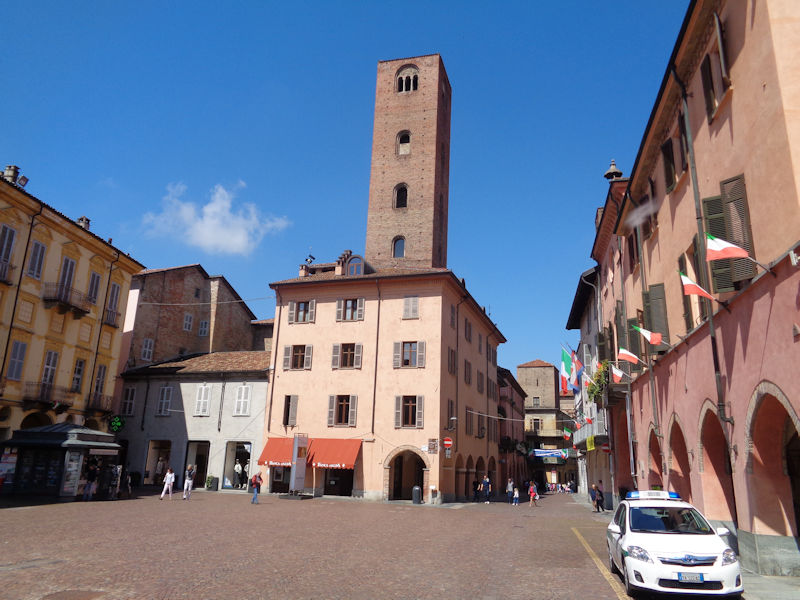
Across the Piazza Duomo and the Via Cavour high street, with on the right the 13th century Palazzo Comunale, housing the municipal administration, police, and tourist information office, with some odds and ends of artworks. The tallest tower in town, in the centre, is the Torre Sineo from the late 11th or early 12th century, about 35m tall.
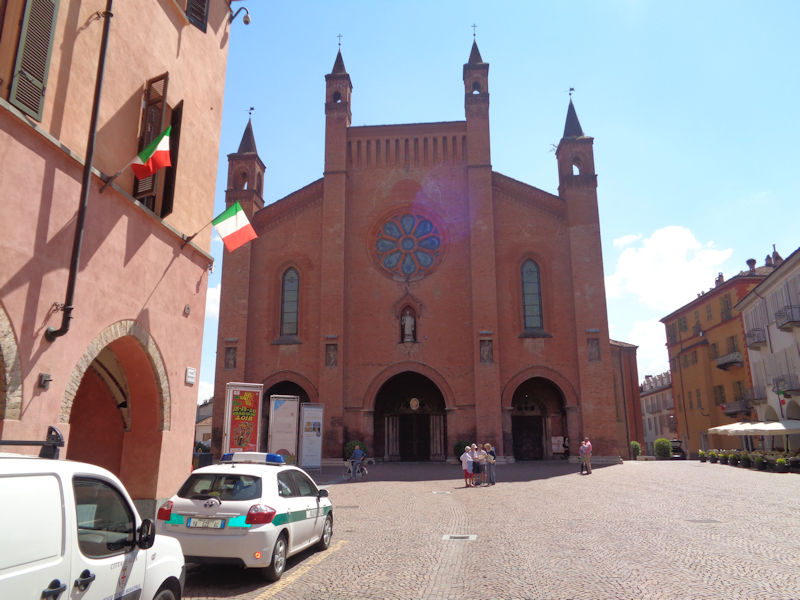
The façade of the Duomo with its rose window and interesting porch or narthex corresponding to the nave and two side aisles
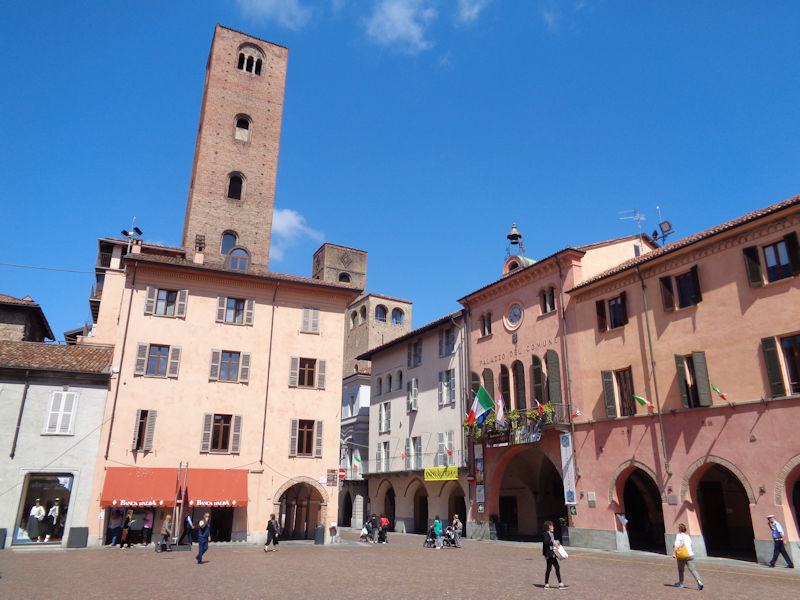
The Palazzo Comunale, built on the site of the Roman forum
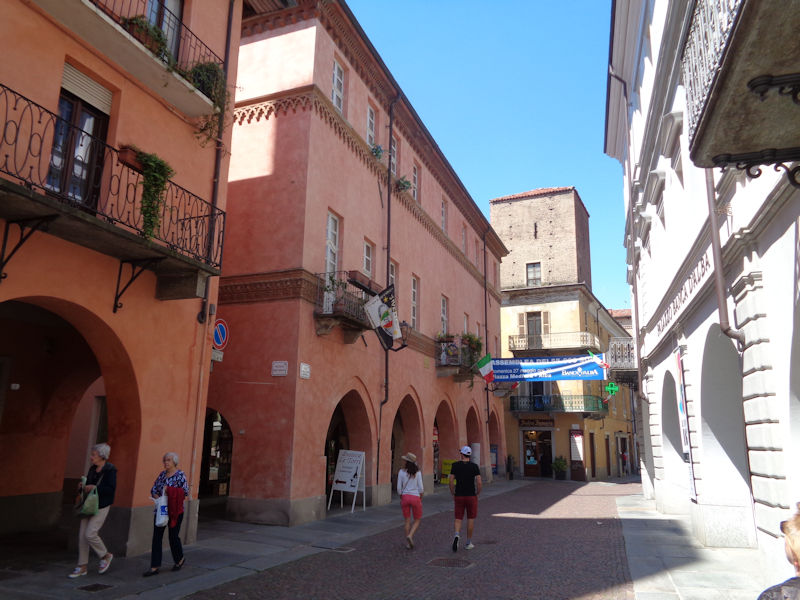
Via Cavour, named for Camillo Benso Conte di Cavour, Prime Minister of the Kingdom of Piedmont-Sardinia during the struggles for liberation from the Austrians and unification of Italy. We'll be visiting his family castle in a few days, located in Grinzane Cavour just up the hill from our apartment.
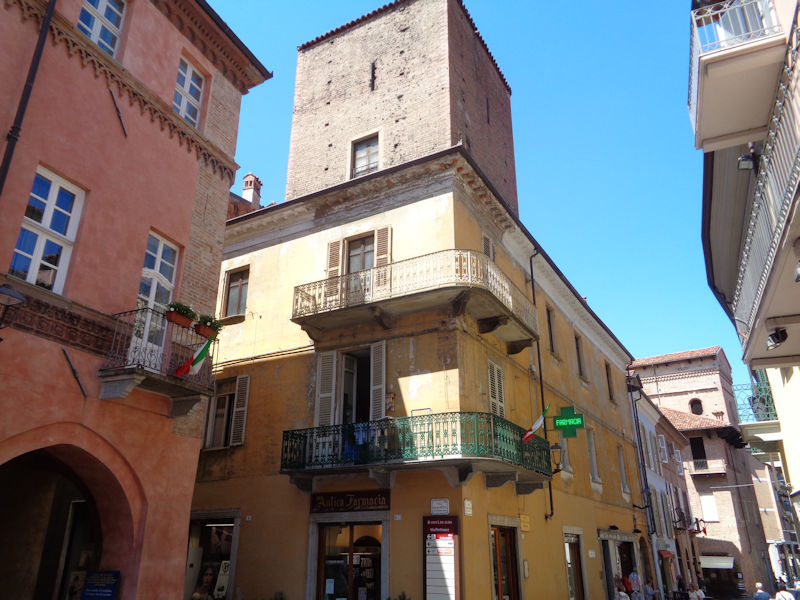
A medieval civic tower, described on the plaque as torre medioevale abbassata, 'shortened'
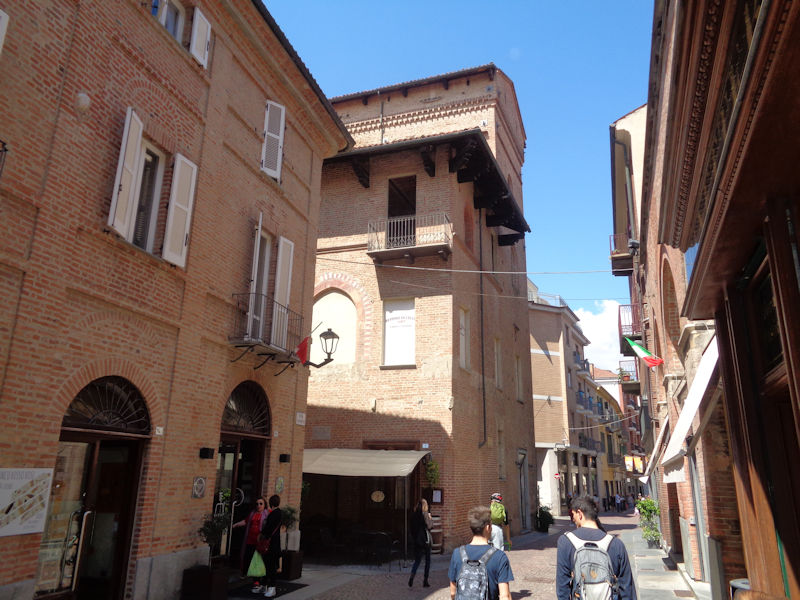
Still on the Via Cavour
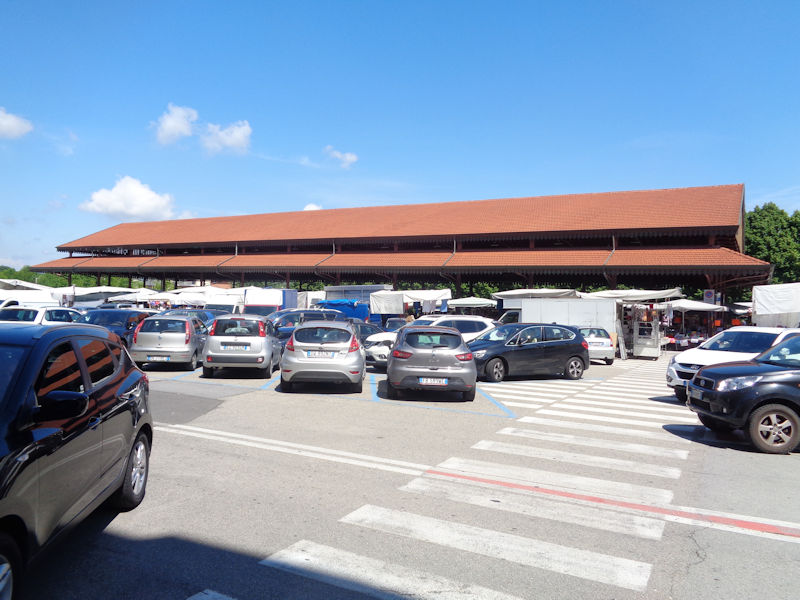
Dashing back to the carpark to put some more money in the meter
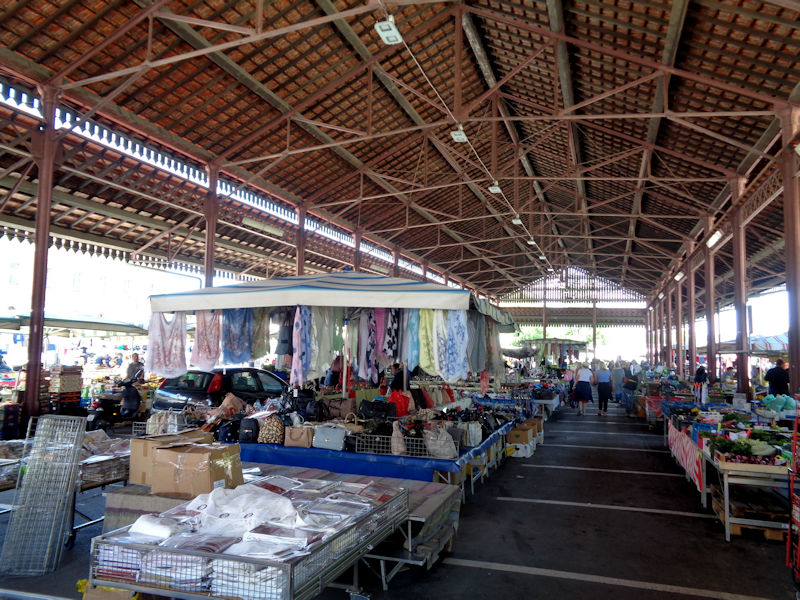
A look around in the covered market
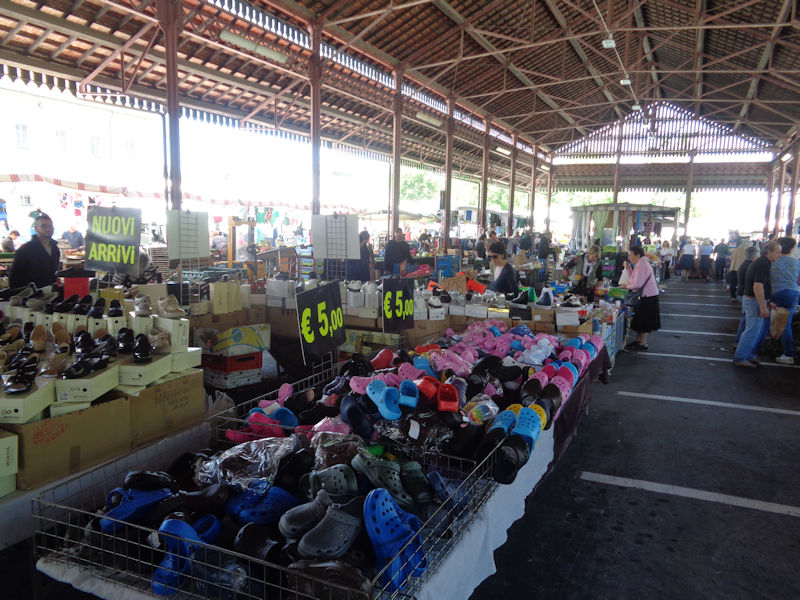
Lots and lots of colorful plastic
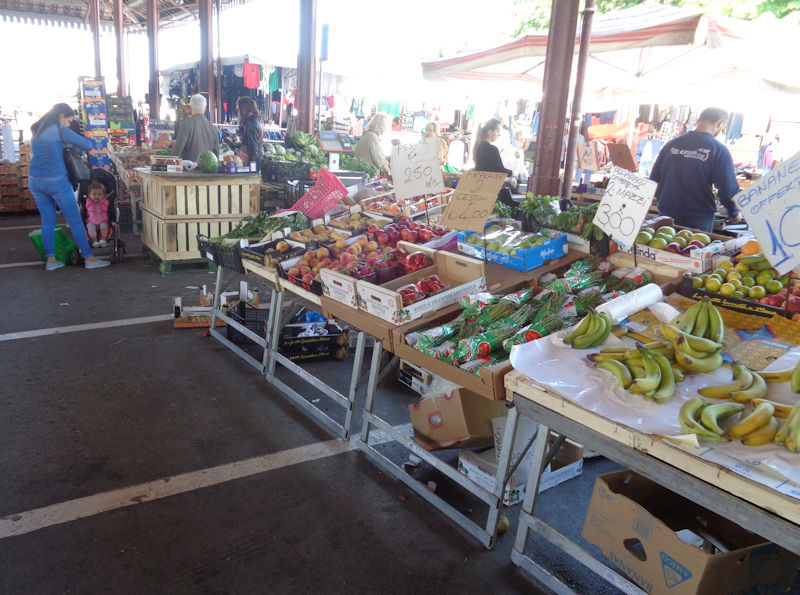
And food
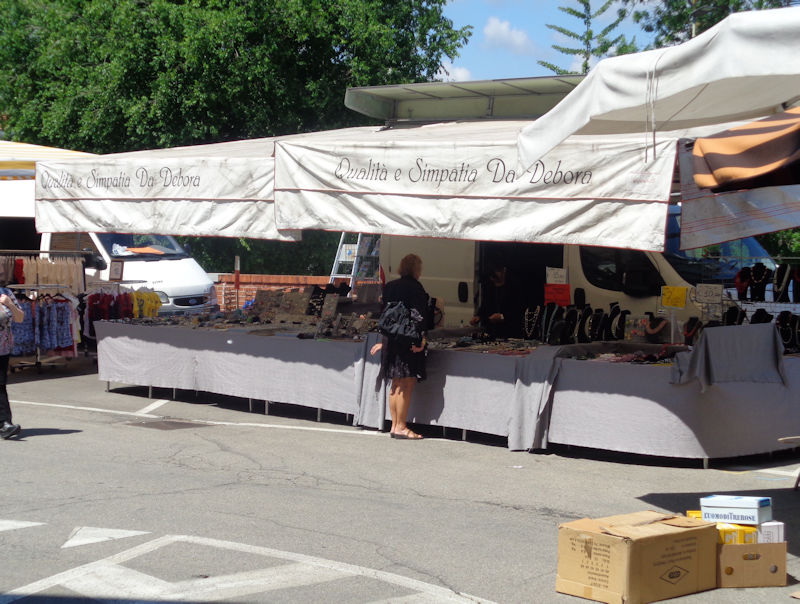
And Kristin in the Inexpensive Jewelry Department
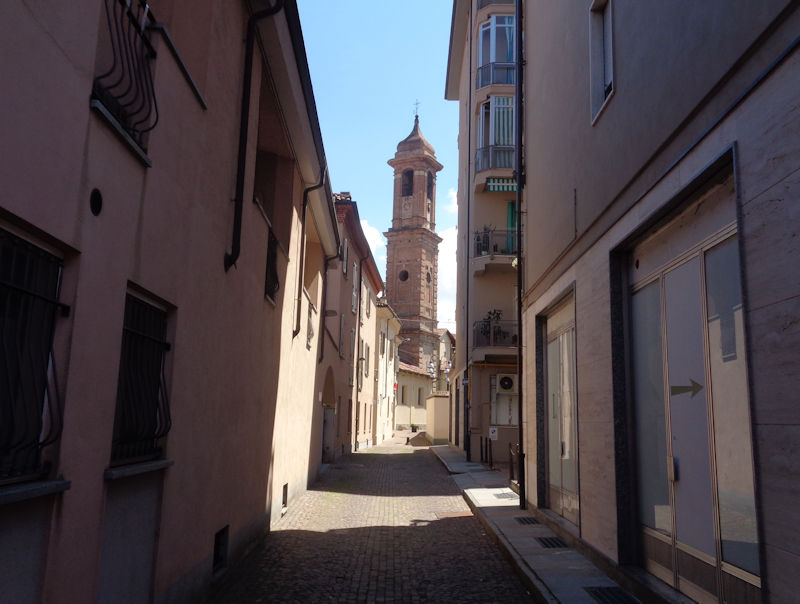
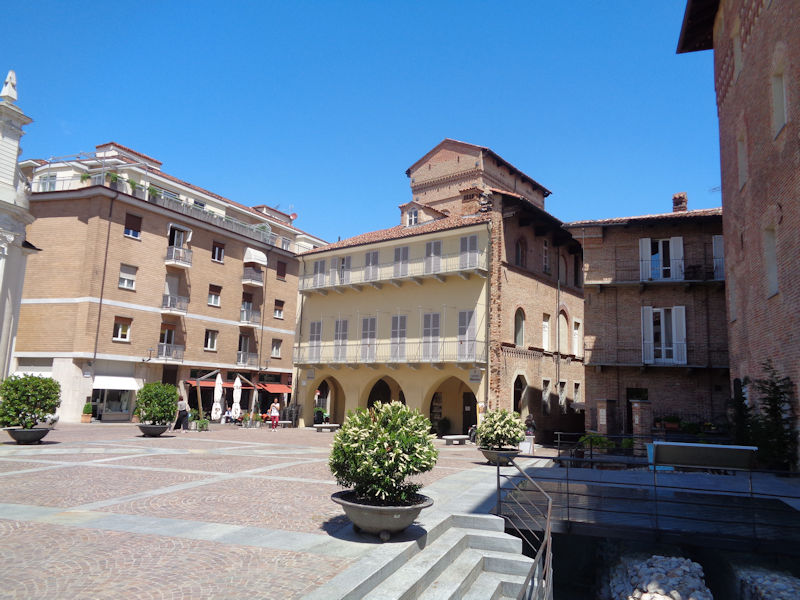
The Piazza Elvio Pertinace two blocks from the Duomo, with . . .
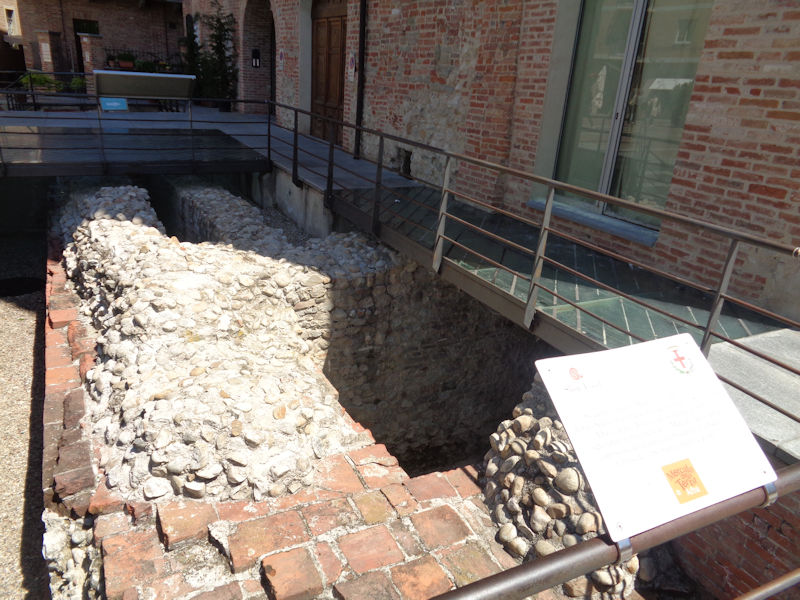
. . . Roman remains under the street. The piazza is named for a native son, Publius Helvius Pertinax, the three-months Roman Emperor in AD 193, the 'Year of the Five Emperors'.
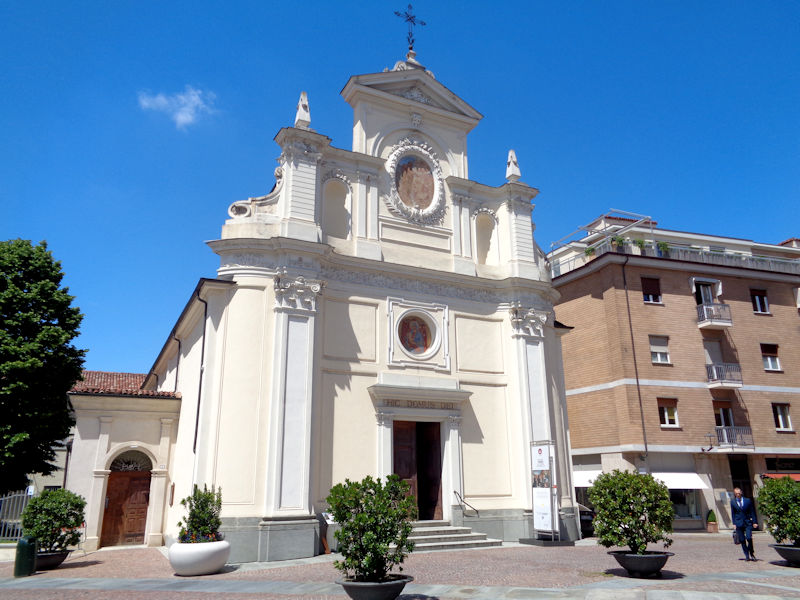
Across the square is the Chiesa di San Giovanni Battista, attested from 1229 and granted in 1556 to Augustinian monks who occupied it and an adjacent convent until 1801, when Napoleon's colleagues used it for a warehouse. It was returned to its church functions in 1819, improved for a while and with major renovations from 1884.
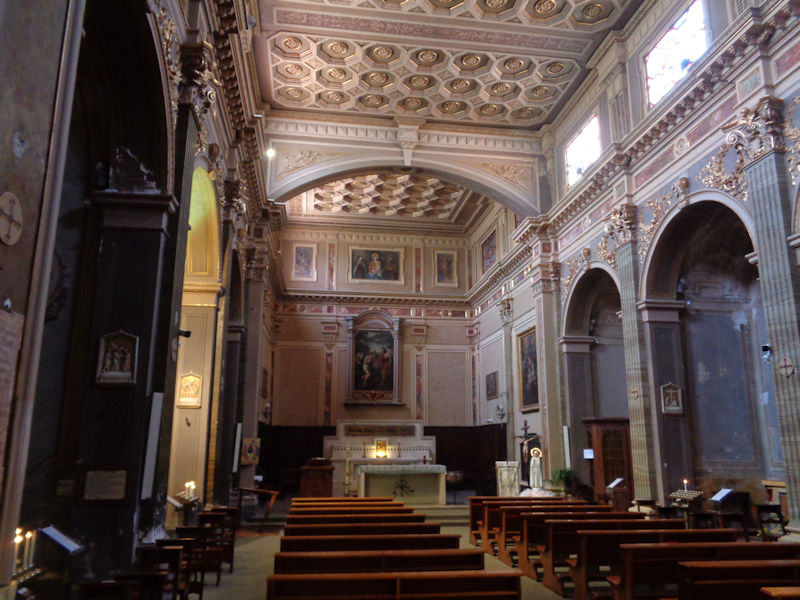
The Baptism of Jesus picture over the altar is said to be by Giovanni Antonio Molineri (ca.1630).
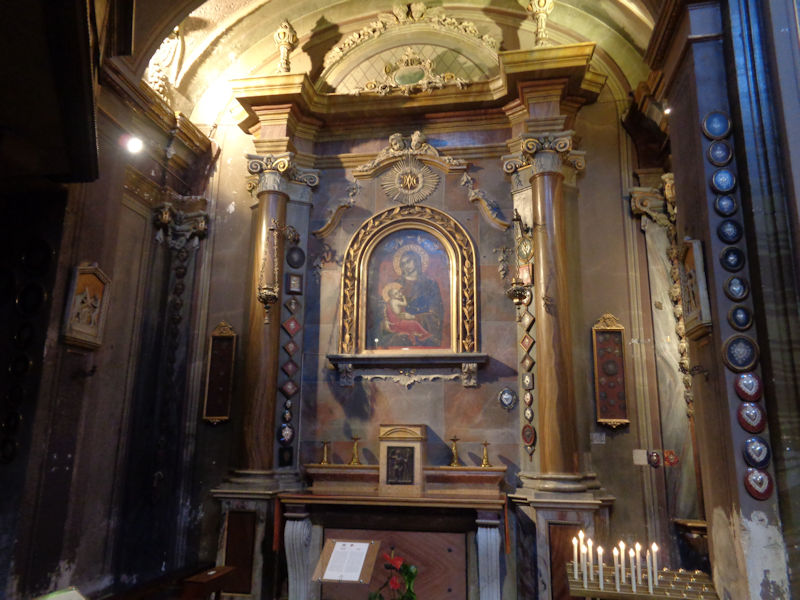
In one of the side chapels, a picture of the Nursing Madonna
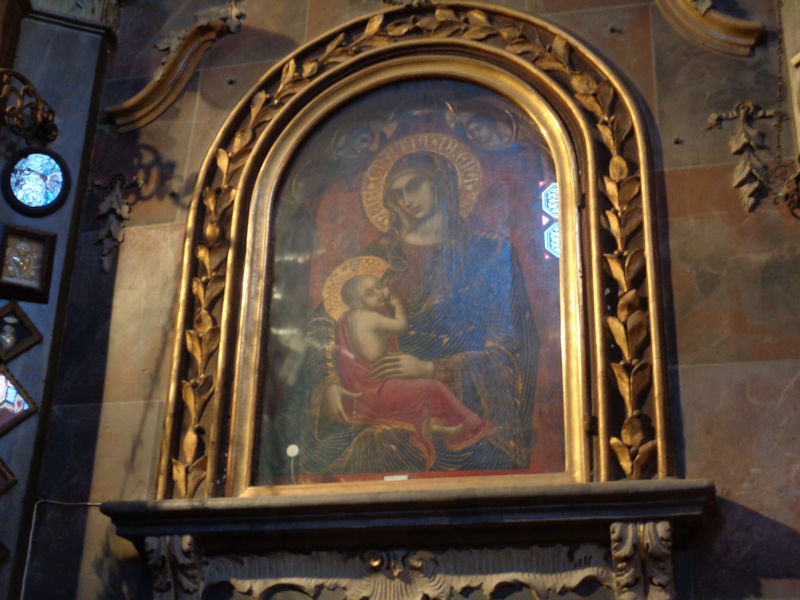
It's signed and dated by Barnaba da Modena from 1377, an early date for having got the nursing anatomy pretty much in the right place.
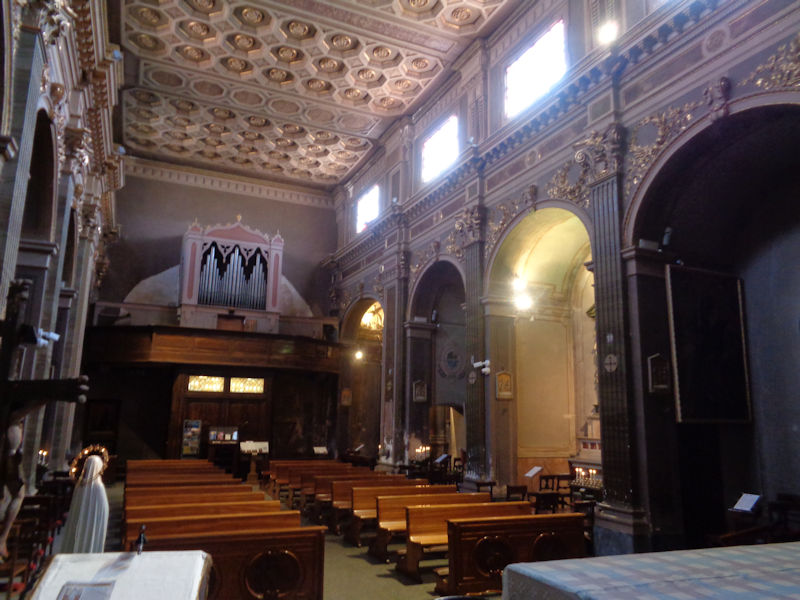
The coffered ceiling is modern.
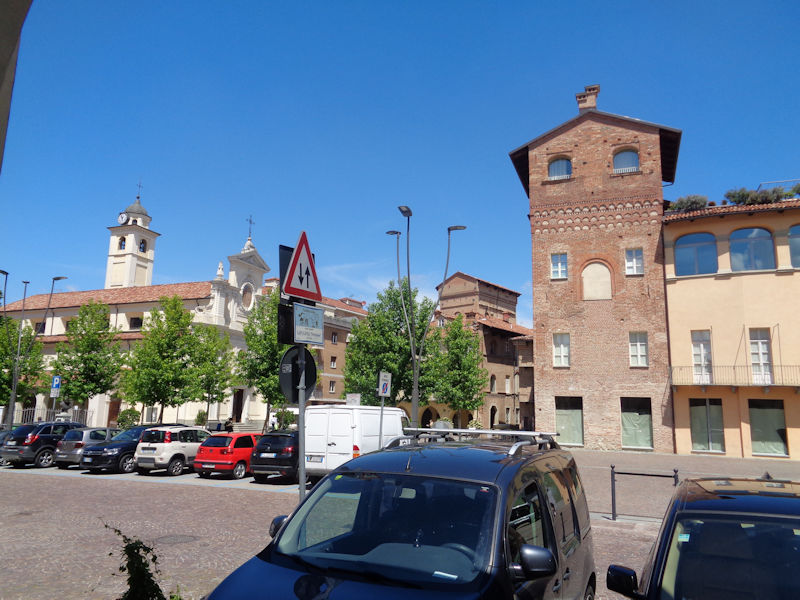
The piazza in front of the Church of John the Baptist hosts the Saturday morning Mercato della Terra Alba, or Earth Market Alba, one of a worldwide network of markets of organic local produce sponsored by the Slow Foods Foundation in collaboration with various farmers' collectives and the city.
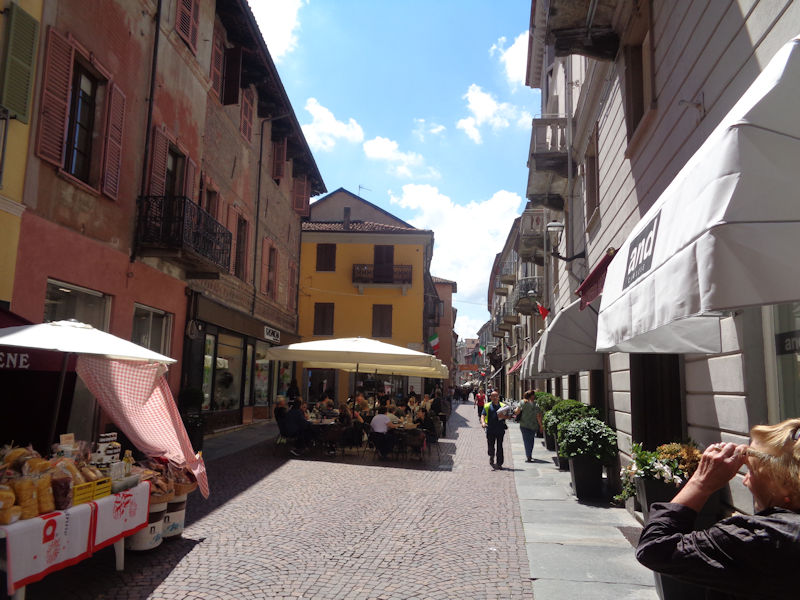
This is the main north-south street, the Via Vittorio Emanuele II. Alba is presently a modern town of about 32,000 citizens, but its origins go back to Celtic and Ligurian times. The Romans valued it, as Alba Pompeia, as a crossing of the Tanaro for the road being built in the early 1st century BC between the towns now called Acqui Terme and Torino or Turin; thus it was officially chartered by the consul Gnaeus Pompeius Strabo, the father of Pompey the Great.
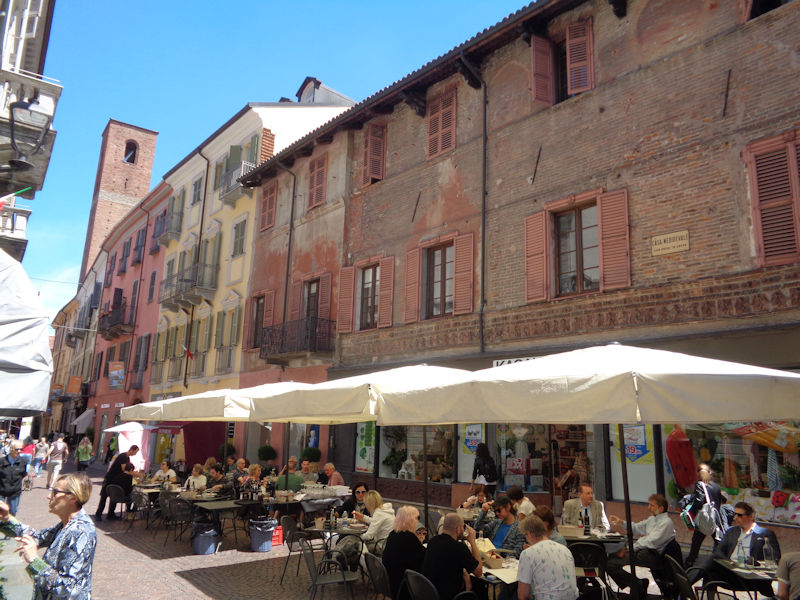
With the decline of the Empire's administration, Alba seems to have become a punching-bag for everybody passing through, being sacked in the 5th and 6th centuries by Ostrogoths, Burgundians, Byzantines, and Lombards, and in the 8th and 9th centuries by Franks, Hungarian Magyars, and Saracen raiders.
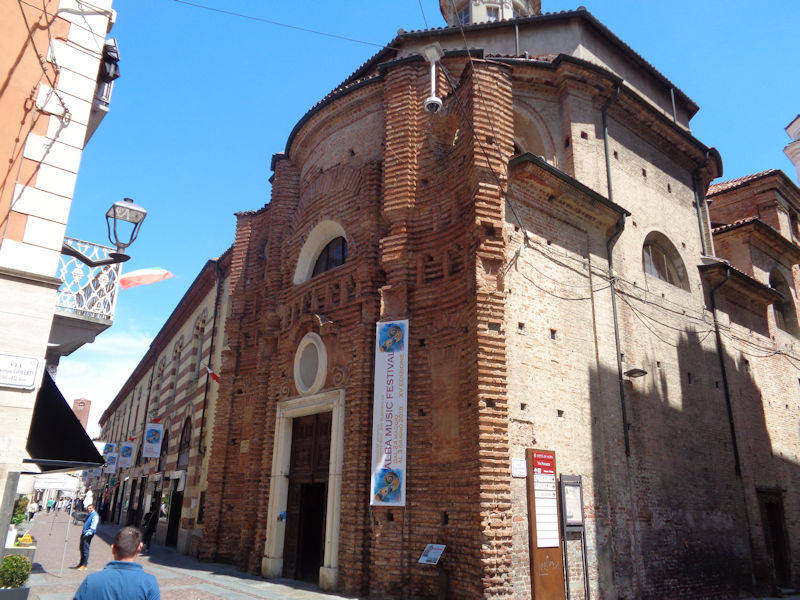
The Chiesa della Maddalena on the Via Vittorio Emanuele II. Like many cities, Alba was administered by its bishop until in the 11th century it became a free commune, but it was still a small player for centuries amid the territorial aspirations of Monferrato, Saluzzo, two branches of the Savoy dynasty, the Visconti of Milan, and later France and Spain. It finally became part of the Duchy of Savoy in 1631 but Napoleon made it the capital of his client state the Republic of Alba in 1796, which lasted for six years.
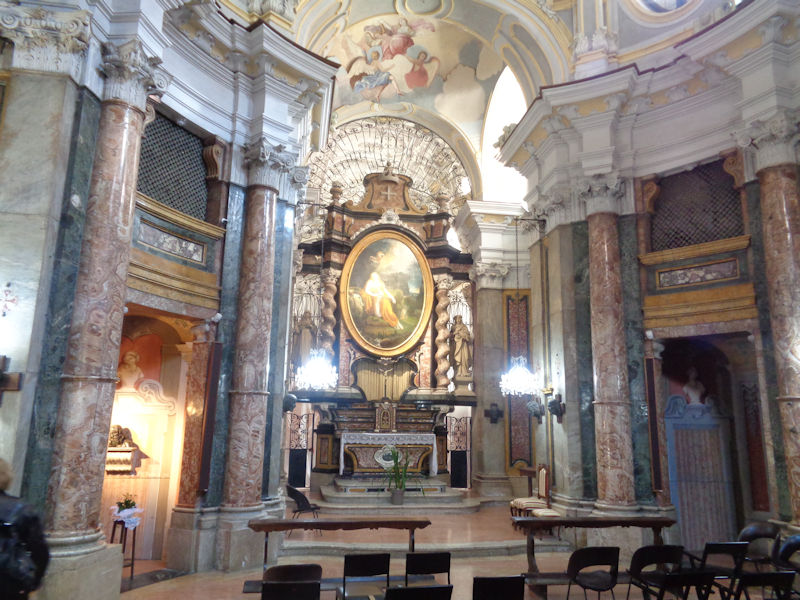
The baroque Church of Santa Maria Maddalena was commissioned on the site of a 13th century church and completed in 1749, though the brick façade was never finished. The iconography throughout the interior is focused on applauding the Blessed Margherita of Savoy, the Dominican order, and the Savoy dynasty.
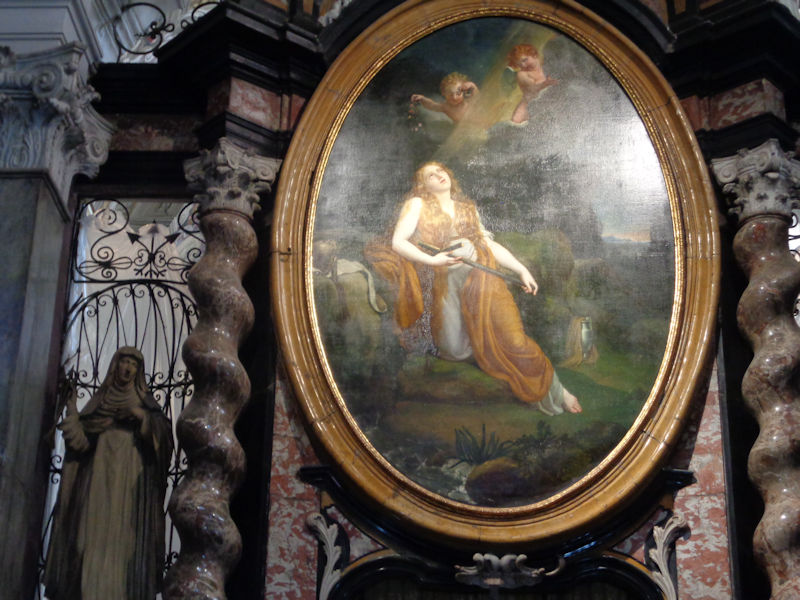
The picture of Mary Magdalene over the main altar, between twisted porphyry columns, is by a fellow called Biscarra in 1825.
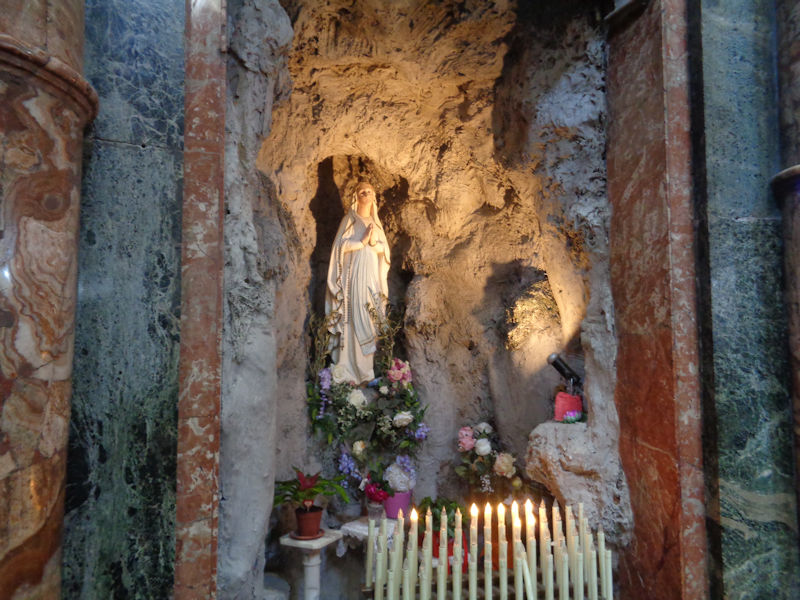
Madonna of the Grotto

This chapel holds a silver urn donated in 1840 by Queen Maria Cristina, widow of King Carlo Felice, to hold the remains of the Blessed Margherita, the Marchioness of Monferrato and a Dominican sister, who had founded a monastery of Dominican nuns in 1448, the premises of which are presently in use for a number of civic institutions, as well as for White Truffles.
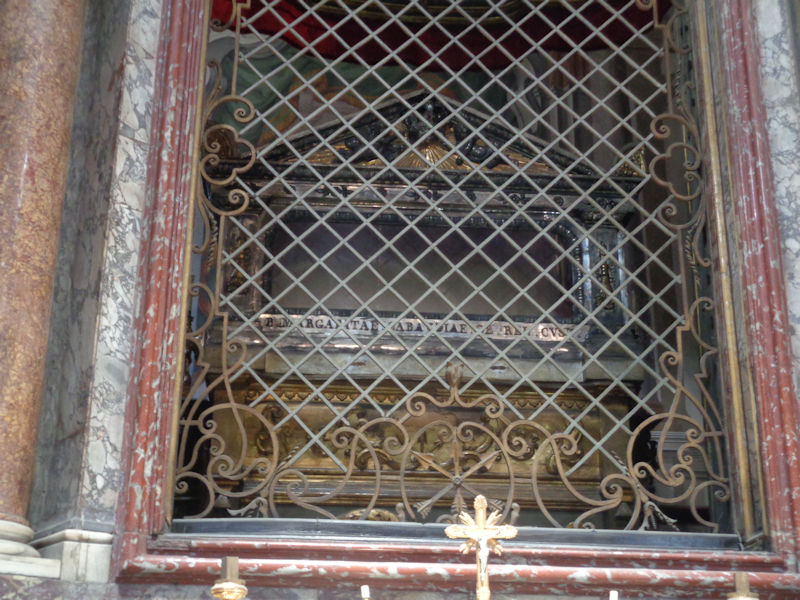
This is Queen Marie Cristina's silver urn, made by the silversmith Pietro Borrani of Torino in 1840, but we've been informed that the Blessed Margaret herself left in 2001, taking her 'uncorrupted body', to reside in a new Dominican convent.
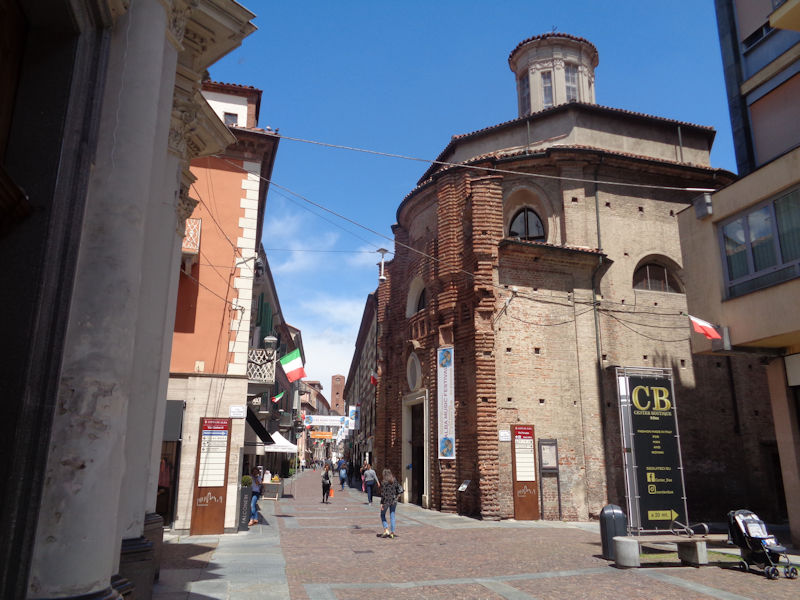
The Magdalene Church again
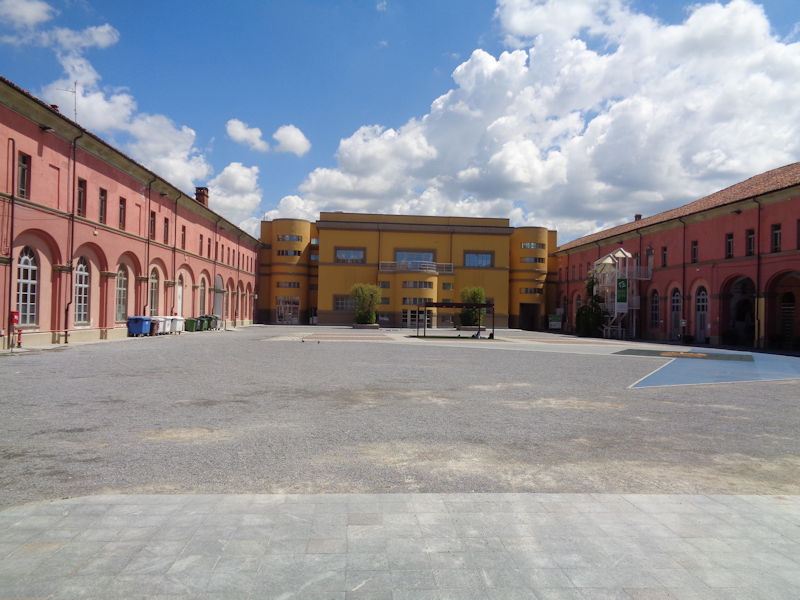
This is the nicely remade Dominican monastic complex, with the Cortile della Maddalena, surrounded by, at the far end, the Sala Beppe Fenoglio (an Alba native who was a noted writer and partisan of the early 20th century whose main themes were the rural world of the Langhe area and the Italian resistance movement), and along the sides, the Museum of Archaeology, the public library, a high school of the arts, and the Institute for Music. And for its famous annual Truffle Festival, featuring the sacred local White Truffle, the trifola d'Alba Madonna.
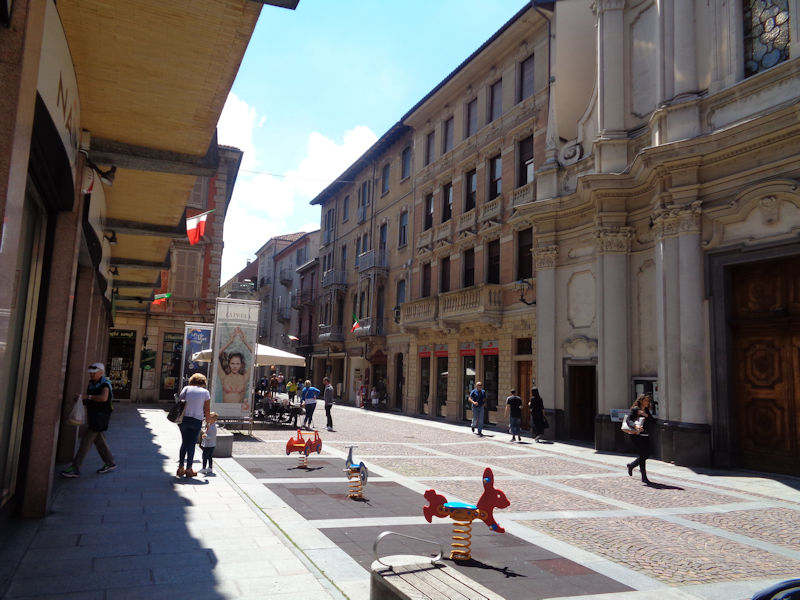
Still on the Via Vittorio Emanuele II. In the negotiations following the fall of Napoleon, Alba was reassigned to Savoy (by then the Kingdom of Sardinia) in 1814 and subsequently joined the Kingdom of Italy. In World War II, local resistance fighters declared a new Republic of Alba in October 1944, but it was retaken by the fascist Republic of Salò some weeks later.
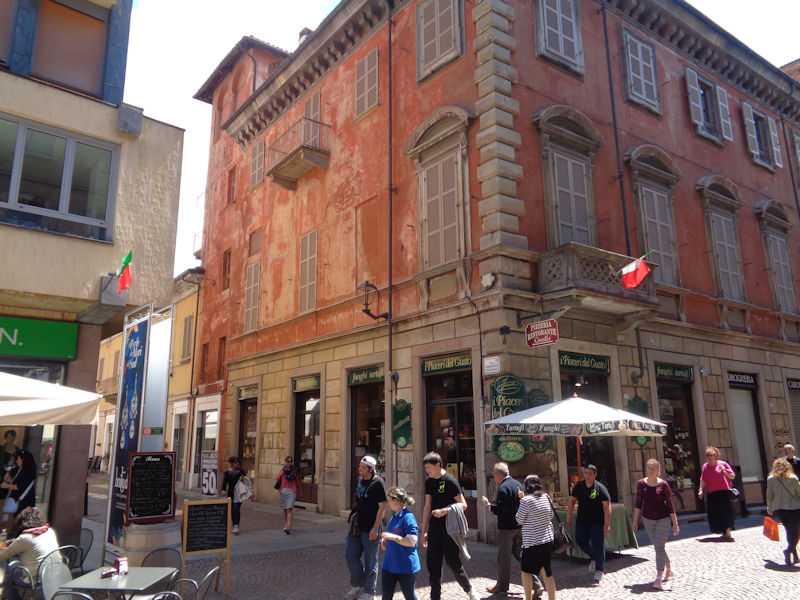
Street scene
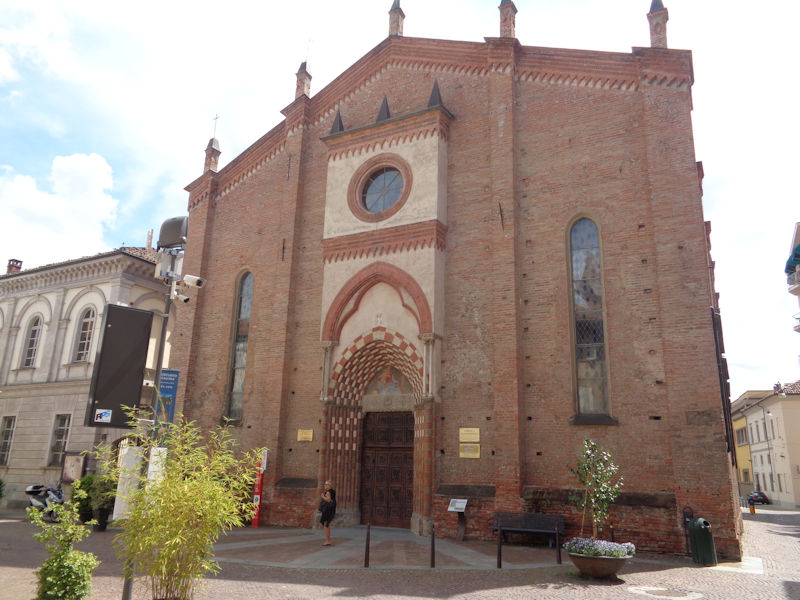
A few blocks over, this is the Gothic Chiesa San Domenico, built in the late 13th century to accompany a Dominican monastery.
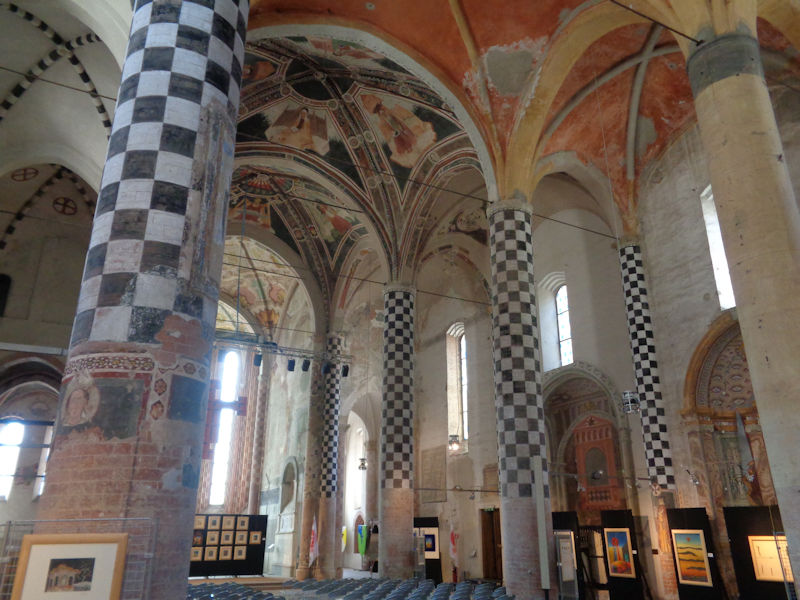
It features a good number of 14th and 15th century frescoes that are worth inspection, and some 16th century ones that have been removed to the Palazzo Comunale.
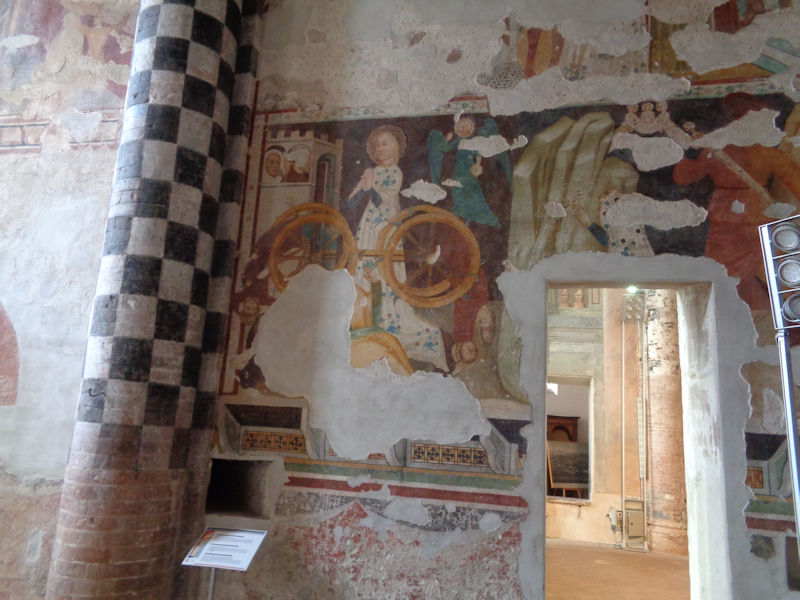
Like these from the life of St Catherine of Alexandria
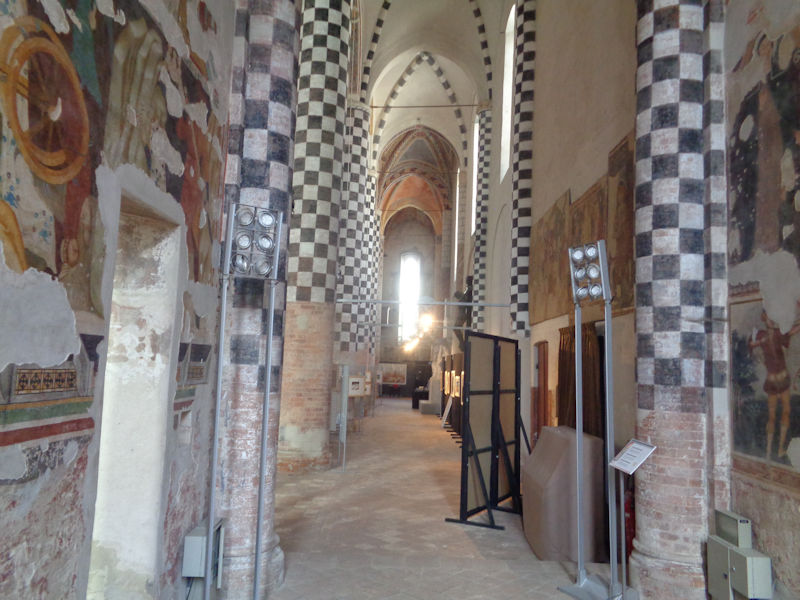
Narrow side aisles
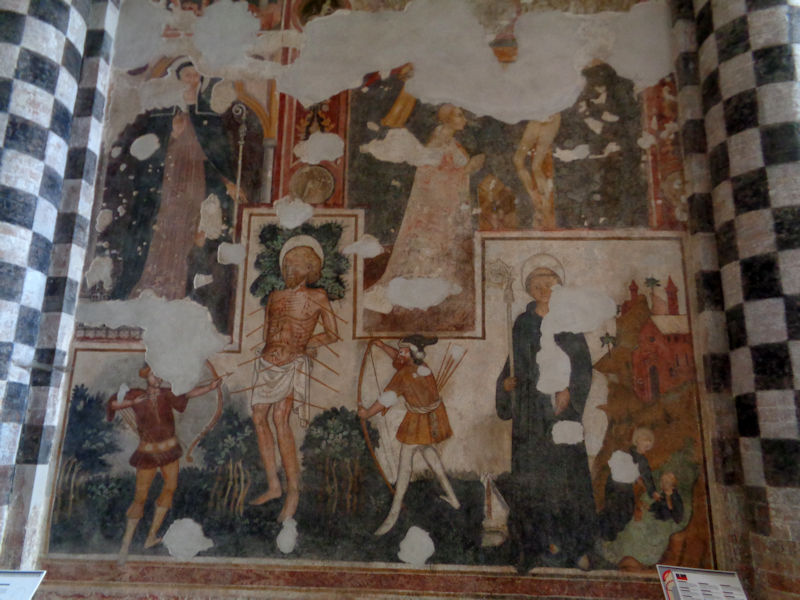 <
<
Poor St Sebastian again
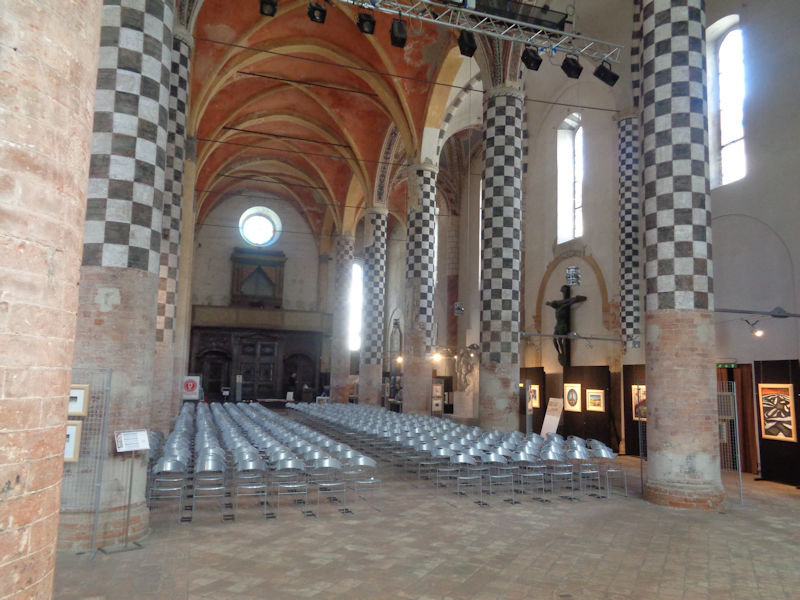
During the Napoleonic Wars the church was used a stable, but it was reconsecrated on 22 June 1827; it presently hosts art exhibits (as above), cultural events, and concerts.
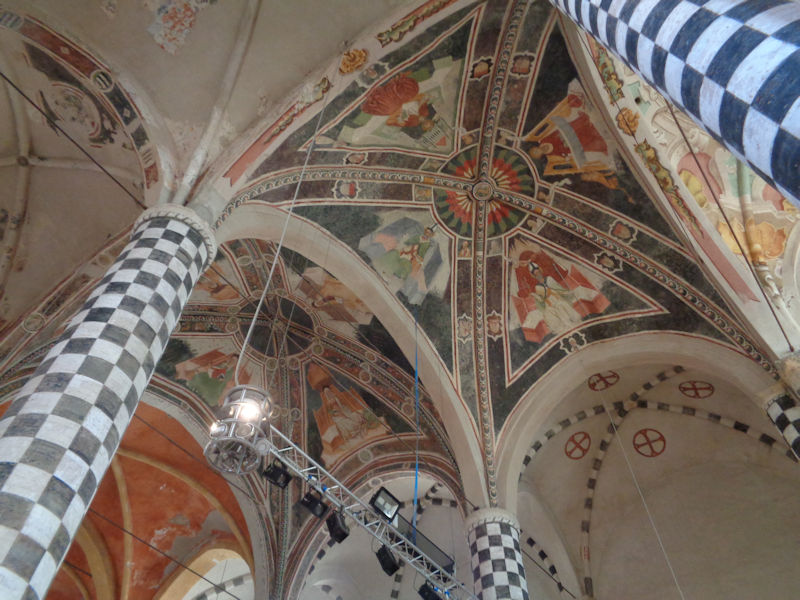
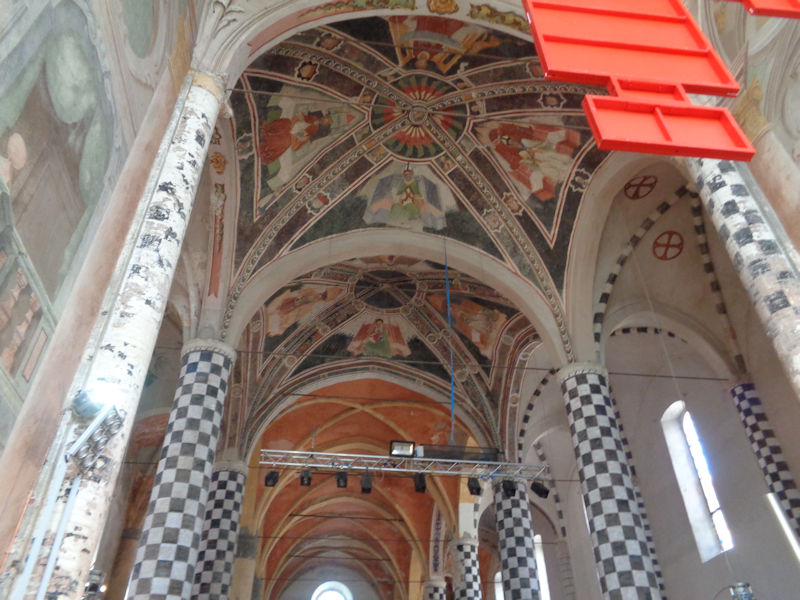
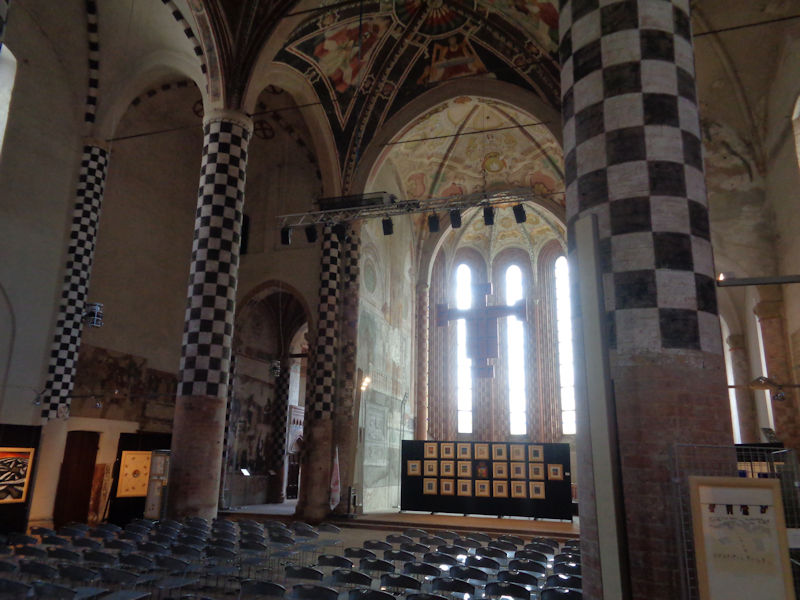
Artwork in front of the main altar
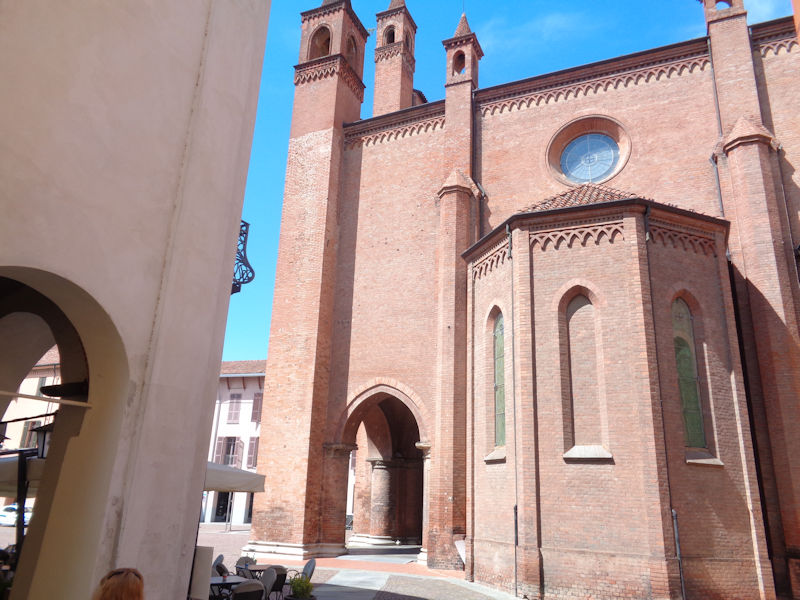
We're on our way back to the carpark, past the porch of the Duomo
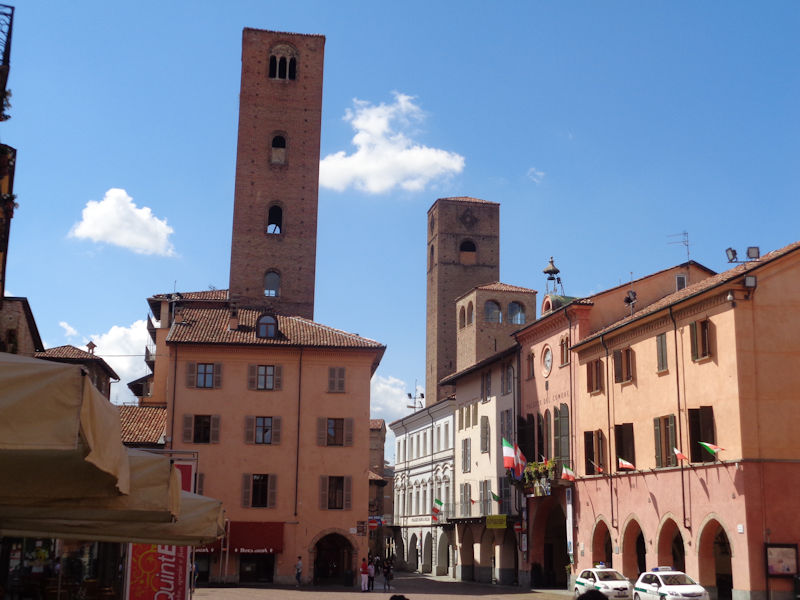
The City of a Hundred Towers
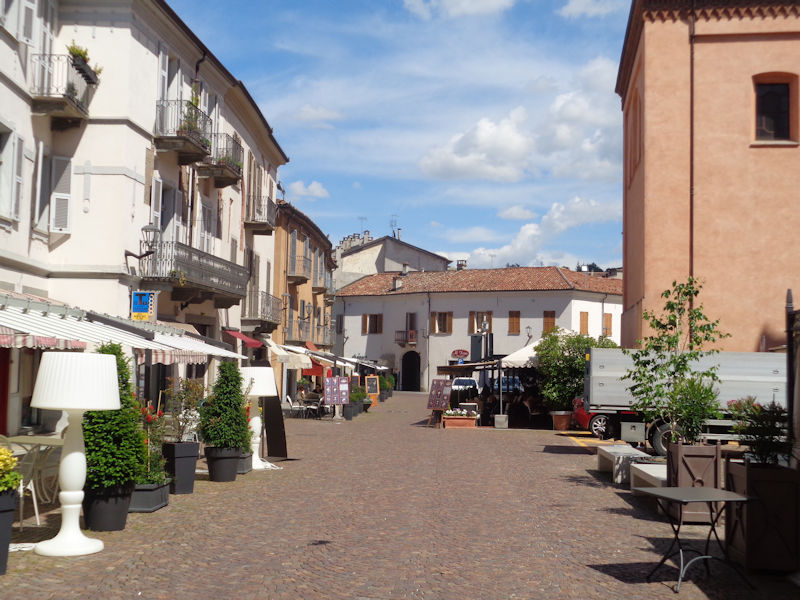
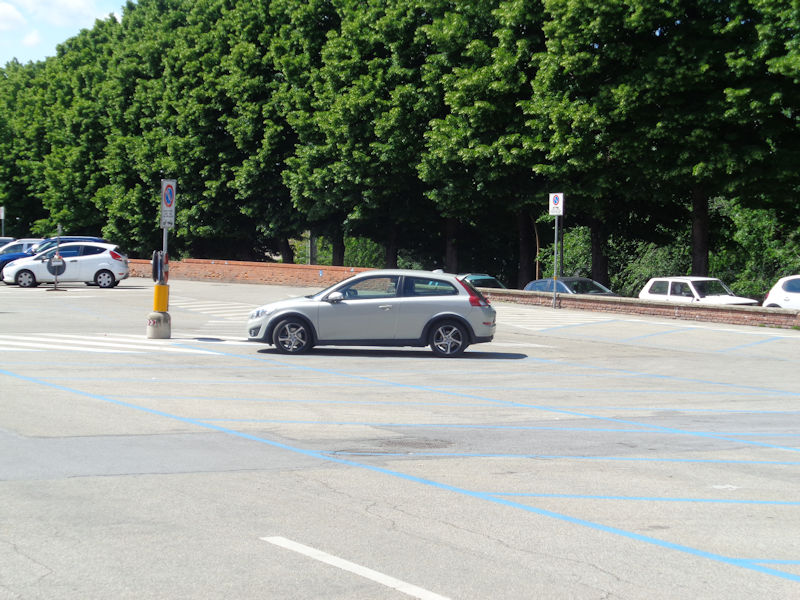
The cute little Volvo, Sven, left to his own devices as the patrons of the market have packed up and gone home. And so shall we.
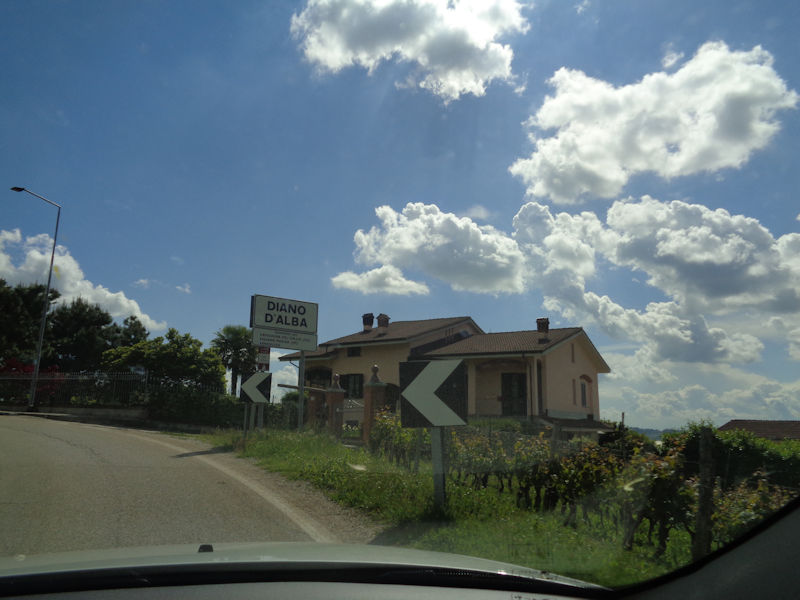
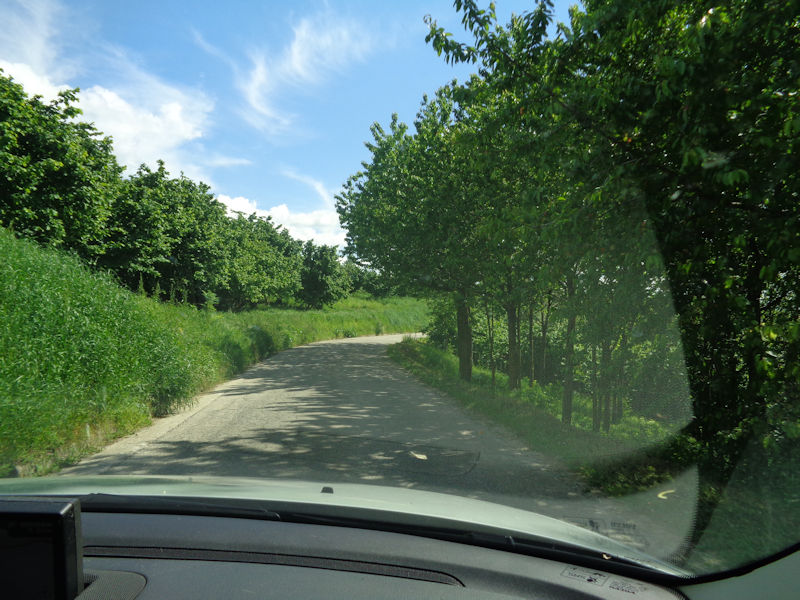 <
<
Back to Valle Talloria, and dinner tonight at the sports pizzeria in the next town, Roddi, featuring an educational demonstration of fly-tying. For catching fish with.
Next: A few castles in the neighborhood

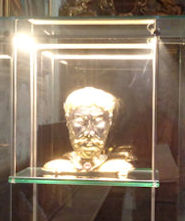 Dwight Peck's personal website
Dwight Peck's personal website





















































 <
<








 <
<